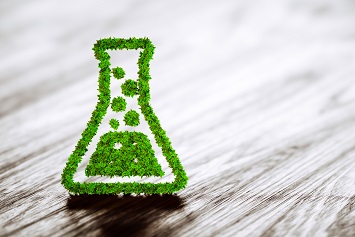Green chemistry and its close relative, sustainable chemistry, are concepts and practices that would seem to have no detractors, not within industry, not among environmental and public health groups, and not throughout the federal and state governments. And yet, while no one appears to publicly oppose these types of chemistry, their integration into the manufacturing and chemical production sectors is occurring slowly.
The reasons are varied and begin with the lack of definitions of the two phrases that stakeholders can agree on. Other obstacles are economic—it costs money to change ingredients and processes to enable a switch from conventional chemistry to green and sustainable chemistries; acceptance—by the public and other purchasers of chemicals and products who are skeptical as to whether they are getting the performance they require; and governmental—an apparent reluctance on the part of the federal government to assist in coordinating and funding innovation and setting standards that would give green and sustainable chemistry a solid foundation on which to grow.
These and related matters were discussed at a July 25, 2019, hearing of the House Subcommittee on Research and Technology. Witnesses were called to discuss their experience with green and sustainable chemistry and the Sustainable Chemistry Research and Development Act (H.R. 2051), a bipartisan bill introduced in April 2019 that has the overall objective of “coordinat[ing] and support[ing] federal research, development, demonstration, technology transfer, commercialization, education, and training efforts in sustainable chemistry, including budget coordination and support for public-private partnerships….” The bill includes no regulatory components and does not authorize new spending.
The U.S. Chemical Industry
The domestic chemical industry plays a formidable role in the American way of life. To illustrate, the American Chemistry Council says that in 2016, the chemical industry supported nearly 26 percent of the nation’s gross domestic product. In addition, the Bureau of Labor Statistics estimates that the chemical manufacturing industry employed more than 858,000 people in June 2019, and the Department of Commerce estimated that the sector generated an additional 2.7 million indirect jobs via industry suppliers. The International Trade Administration of the Department of Commerce identifies the chemical industry as one of the largest manufacturing industries in the United States, with more than 10,000 companies producing more than 70,000 products.
These figures indicate that any substantial shift to green and sustainable chemistries can have a profound impact on the business of chemistry; employment; the environment; and, potentially, human health.
Principles
The concept of green chemistry has been around at least since the early 1990s when Paul Anastas, PhD, then a chemist with the EPA, coined the phrase. According to Anastas, the overall goal of green chemistry is the “the design of chemical products and processes that reduce or eliminate the use and generation of hazardous substances.” Anastas later collaborated with John C. Warner, a witness at the hearing, on establishing 12 green chemistry principles. The full list of principles is provided in Warner’s testimony; the principles include:
- Prevention. It is better to prevent waste than to treat or clean up waste after it is formed.
- Less hazardous chemical synthesis. Whenever practicable, synthetic methodologies should be designed to use and generate substances that possess little or no toxicity to human health and the environment.
- Designing safer chemicals. Chemical products should be designed to preserve efficacy of the function while reducing toxicity.
- Safer solvents and auxiliaries. The use of auxiliary substances (solvents, separation agents, etc.) should be made unnecessary whenever possible and, when used, innocuous.
- Design for energy efficiency. Energy requirements should be recognized for their environmental and economic impacts and should be minimized. Synthetic methods should be conducted at ambient temperature and pressure.
- Use of renewable feedstocks. A raw material or feedstock should be renewable rather than depleting whenever technically and economically practical.
The concept of sustainable chemistry is a more recent development and encompasses a broader field. Warner, who heads the Warner Babcock Institute for Green Chemistry, made the following distinction:
“Sustainable chemistry is a large umbrella concept that addresses the many aspects of the chemical supply chain, including manufacturing improvements, remediation technologies, exposure controls, and recycling technologies. Green chemistry specifically focuses on the inventive process to reduce or eliminate the use and generation of hazardous material in the first place. One way to look at it: sustainable chemistry focuses on what a technology does. [G]reen chemistry focuses on what a technology is. Green chemistry addresses issues with the solvents, the catalysts, the toxicity, the renewability, the biodegradability.”

The Importance of Definitions
In a 2008 report called “Chemical Innovation,” the U.S. Government Accountability Office (GAO) noted that what is actually being achieved in green and sustainable chemistries and a forward path toward increasing the role of those sciences is dependent on all stakeholders settling on the same definitions. At the House hearing, Timothy M. Persons, a senior GAO scientist, said that in researching the report, the GAO found that stakeholders vary in how they define sustainable chemistry, how they assess sustainability, and which environmental and health factors they considered most important.
“Without a standard definition that captures the full range of activities within sustainable chemistry, it is difficult to define the universe of relevant players,” testified Persons. “Without agreement on how to measure the sustainability of chemical processes and products, companies may be hesitant to invest in innovation they cannot effectively quantify, and end users are unable to make meaningful comparisons that allow them to select appropriate chemical products and processes.”
Persons added that currently, there is no mechanism for coordinating a standardized set of sustainability factors across the diverse range of stakeholders despite the motivation of some specific sectors to do so.
“Moreover, although the federal government has worked with stakeholders through its research support, technical assistance, certification programs, and other efforts, there are still gaps in understanding,” Persons said. “Many stakeholders told us that without such basic information as a standardized approach for assessing the sustainability of chemical processes and products, better information on product content throughout the supply chain, and more complete data on the health and environmental impacts of chemicals throughout their life cycle, they cannot make informed decisions that compare the sustainability of various products.”
A Broader Definition of Sustainable Chemistry
The critical role of clear definitions was also addressed by Julie Beth Zimmerman, the deputy director of the Center for Green Chemistry and Green Engineering at Yale University. As with Persons and the GAO, Zimmerman wants to see a clear road ahead that all stakeholders can agree on.
“Vague, nebulous, and plentiful definitions of a single concept are antithetical to bringing about the kind of alignment and focus that the new concept is trying to drive,” testified Zimmerman. “In other words, if people are confused about what sustainable chemistry even is, it is difficult to imagine that from that confusion will arise a clear path on how to attain it.”
One consequence of the absence of accepted definitions is that work that is neither green nor sustainable will be identified as such by those performing it.
“When sustainable chemistry is defined so broadly as to include all of work related to chemicals, health, and the environment, then this leads to a meaningless collection of disparate and disjointed work, much of which does not comply with the goals and definition of green chemistry,” said Zimmerman.
Zimmerman is also concerned that there may be a trend focusing on sustainability in chemistry without ample involvement of green chemistry. The following comment by Zimmerman suggests why arriving at universal definitions may be so difficult:
“If, as some have suggested, sustainable chemistry is merely using chemistry to address sustainability problems such as those addressed in the United Nations’ Sustainable Development Goals (e.g., climate change, energy generation, water purification, food production, or the manufacture of medicines), regardless of adhering to the principles of green chemistry, [that] would allow for the high potential of tragic unintended consequences. These are sometimes referred to as ‘doing the right things wrong.’ Therefore, any construct of genuine sustainable chemistry would need to recognize that Green Chemistry needs to be its centerpiece, heart and soul, central and essential element and that systems level thinking and life cycle assessments are essential to the tasks at hand. However, as we recognize that there is more to a sustainable world than just chemistry, we need to recognize that there are and should be many more aspects to sustainable chemistry than green chemistry. These aspects should enable and empower the conduct and impact of the chemistry of sustainability. This requires an ecosystem of economics, policy, interdisciplinary engagement, equity, education, regulation, metrics, and awareness.”

Bill Would Initiate Federal Coordination
As noted, the main objective of H.R. 2051 is to ensure that federal agencies cooperate and coordinate in their support of sustainable chemistry. The bill would require creation of a National Coordinating Entity for Sustainable Chemistry. The Entity would include “subject matter experts” from the EPA, the National Institute of Standards and Technology, the National Science Foundation, the Department of Energy, the Department of Agriculture, the Department of Defense, the National Institutes of Health, the Centers for Disease Control and Prevention, the Food and Drug Administration, and any other appropriate agency. No later than 2 years after its formation, the Entity would be required to produce a working framework that would include a sustainable chemistry benchmark from which progress can be measured; identification of the barriers to innovation; and identification of the methods by which federal agencies can facilitate incentives for development and use of sustainable chemistry processes and products, including innovative financing mechanisms.
The bill’s authors also carve out a section specifically intended to resolve at least some of the differences regarding definitions, which the bill describes as characterizing the attributes of sustainable chemistry. To better understand these attributes, the Entity would need to:
- Consider existing definitions of or frameworks characterizing sustainable or green chemistry already in use at federal agencies.
- Consider existing definitions of or frameworks characterizing sustainable or green chemistry already in use by international organizations of which the United States is a member, such as the Organisation for Economic Co-operation and Development.
- Consider any other appropriate existing definitions of or frameworks characterizing sustainable or green chemistry.
Witnesses at the hearing voiced support for H.R. 2051, with representatives of the American Chemistry Council (ACC) and BASF Corporation being particularly enthusiastic.
“We welcome and support the establishment of an interagency sustainable chemistry workgroup to promote and coordinate federal sustainable chemistry research, development, educational and training activities,” said ACC’s Anne Womack Kolton. “This legislation will play a key role in supporting and enabling technology and tools that can help advance the sustainable chemistry innovations our members are developing.”

